Constructing Identity
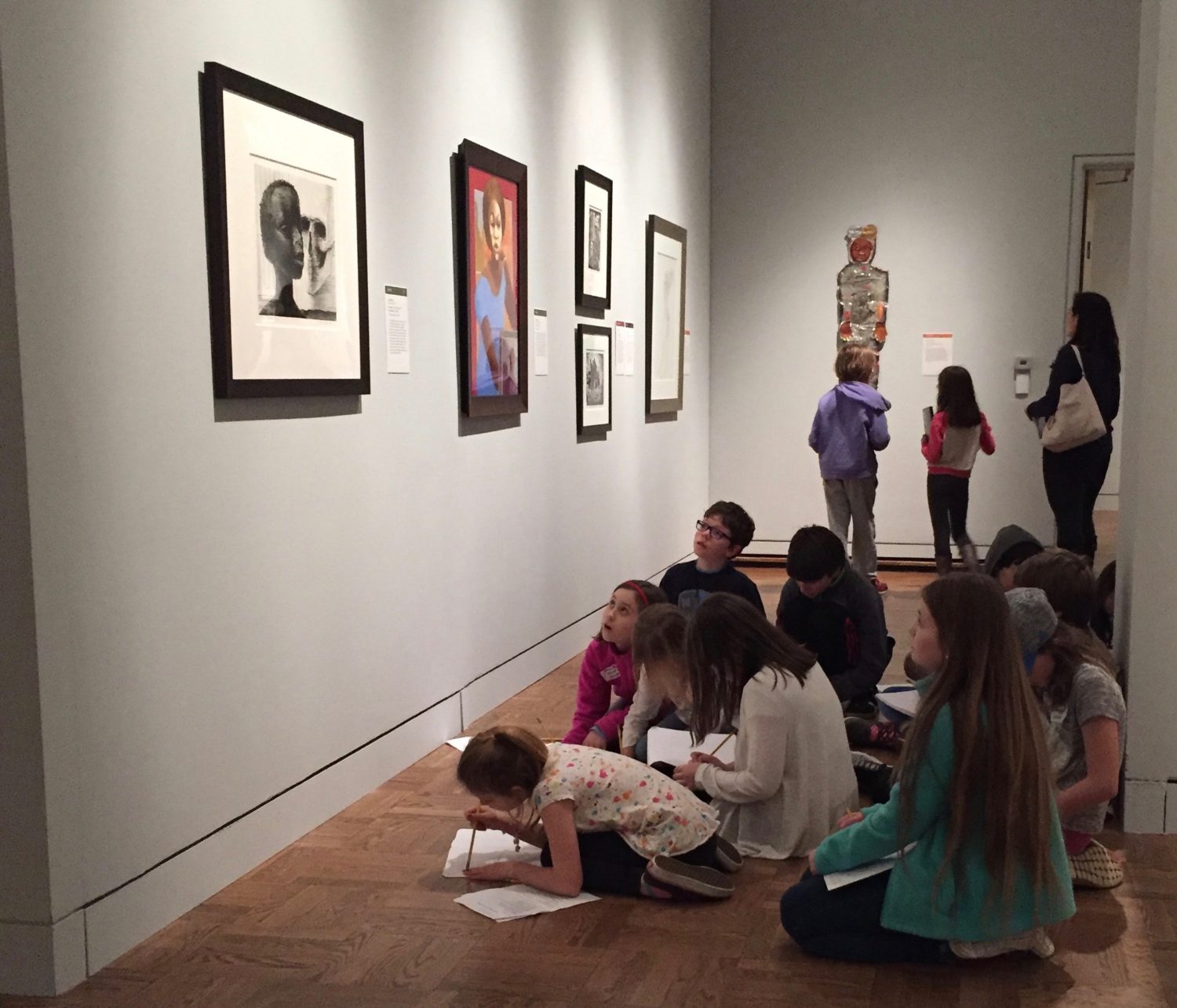
Because it’s Opal 4, we knew we would deeply explore the complexities of perspective this year. Because it was a presidential election year, we knew we would be thinking together about the issues and the process. Because 4th and 5th graders have a right to know their state’s history, we knew we would focus on stories of Oregon. And because immigration was such a focal point of political rhetoric, we knew we would be working together to understand the immigration and migration stories in our own families, asking what it means to be an Oregonian. These preconceived intentions prepare our minds to be favored by chance. It never fails.
By chance the Portland Art Museum opened a new exhibition, “Constructing Identity“, from the Petrucci Family Foundation Collection of African American Art. They had handed us a resource that could not have been more relevant to our work. We accepted the open invitation to go explore.
As I was planning our trip, my mind was prepared with the anticipation of this excursion, and so when I stumbled on the metaphor of “windows and mirrors” one night while reading the Teaching Tolerance website, I knew it would help us approach the artwork we would see. And as I opened the New York Times on my computer one evening this same week, a new video series called “Hyphen-Nation” was there on the front page. I didn’t realize I’d been looking for that, either, but there it was. It is arguable, I guess, that we are more prepared when we rely less on planning and more on paying attention. I can go on. I introduced the concept of windows and mirrors to the group and 11-year-old Alijah said, “Oh, I think someone has a TED talk about that.” I went searching for that and found it was author Grace Lin. Her 12-minute talk was precisely related to what we were talking about. So we watched it. And by chance, I was exploring Powell’s Books one morning just because the rest of our city happened to be shut down with ice, and I discovered the 2017 Caldecott Honor book, They All Saw a Cat. So we read it.
But I’m getting ahead of myself.
This process is, I think, really a matter of, or maybe a result of, staying awake. But also, it’s a matter of understanding that if the classroom is to be in the world and the world is to be in the classroom, it’s our job to pull the two together. It’s our job to help the children see that the things they are concerned with are part of the world outside the classroom. The things they think about and care about that live within our predetermined frame of intent are alive in the concerns of all humanity — now, and in all that came before us. (And if they aren’t, well, perhaps it’s time to consider reframing our intentions.)
It takes time to develop understanding, so we spent time in the week before our visit to the art museum involved in a common Opal School practice aimed at uncovering and co-creating meaning. We “cracked open” the word “identity” and looked inside. As my colleague Tara wrote in a recent post, “We believe there’s a world within a word, and we invite the children to find themselves within these word-worlds… The process of cracking open words and the outcome, a growing web of shared language, strengthens the children’s sense of agency and belonging. It demonstrates how teachers are not transmitters of information and children are not consumers of it. At an early age, these children know they are culture makers.” Taking a peek into the world that lives inside the word “identity” primed the children to situate the title of the exhibit within the meaning they negotiated for themselves, in reference to one another. When you own the language, you own the culture. We don’t need to tell children what words mean nearly as often as we need to ask them what meaning they are making of words. When we do that, the children participate in culture making, and, through a process of reflection, they can become aware that they are.
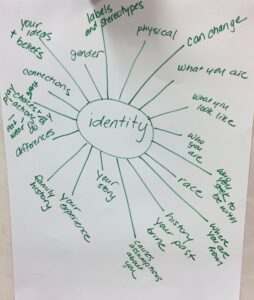
Because the children expect to find a place for themselves in the things we do in school, I knew I could expect authentic attempts at making meaning of the art in the “Constructing Identity” exhibition, and so I needed to focus on setting them up to be able to share the meanings they were making. My goal was to support the children to see each piece in the collection as a kind of long-distance offer of connection from one artist to another. I didn’t need to tell them how to connect with the art, how to find meaning in it — I just needed to ask them to, and I needed to give them some tools to do so.
I assigned them each a partner with whom to find eleven different pieces within the exhibition. This was a game they enjoyed as though it were a scavenger hunt of some kind, made even more enjoyable by the fact that they could tell I’d paired them each with a very good friend — something they know I don’t always do. Also importantly, I told them that they did not have to find all eleven. I had chosen that many to try and accommodate the varied temperaments of the pairs. Some would find two or three and dive deeply into those, and some would be more determined to find them all. Either was okay. Either met my intentions to have these artists connect with one another. The final condition that seemed to make the experience successful was that they were independent. As long as they were visible within the gallery to the adults they were with — they were on their own to work. And so they got to it.
Once they found a piece, they were expected to use their sketchbooks to capture the art in pencil and annotate their drawing. They were asked:
- What might the artist be trying to say about their own identity?
- What about the art expresses identity?
- Where are the windows? Where are the mirrors?
- What is abstract? What is real? What is true?
Here are some representative samples of what was collected:
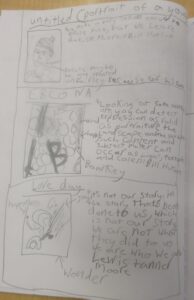
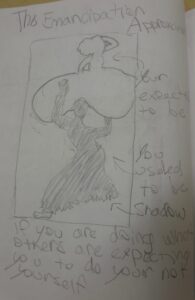
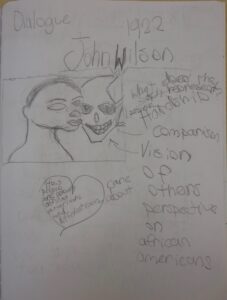
These twenty-six 9, 10 and 11 year-olds had about two hours in the museum’s galleries that day. I wish that anyone who ever doubted that children were capable of being self-directed, engaged, quiet, and focused in an art museum had been able to observe them for a time. The only slight commotion happened when we had to drag them away.
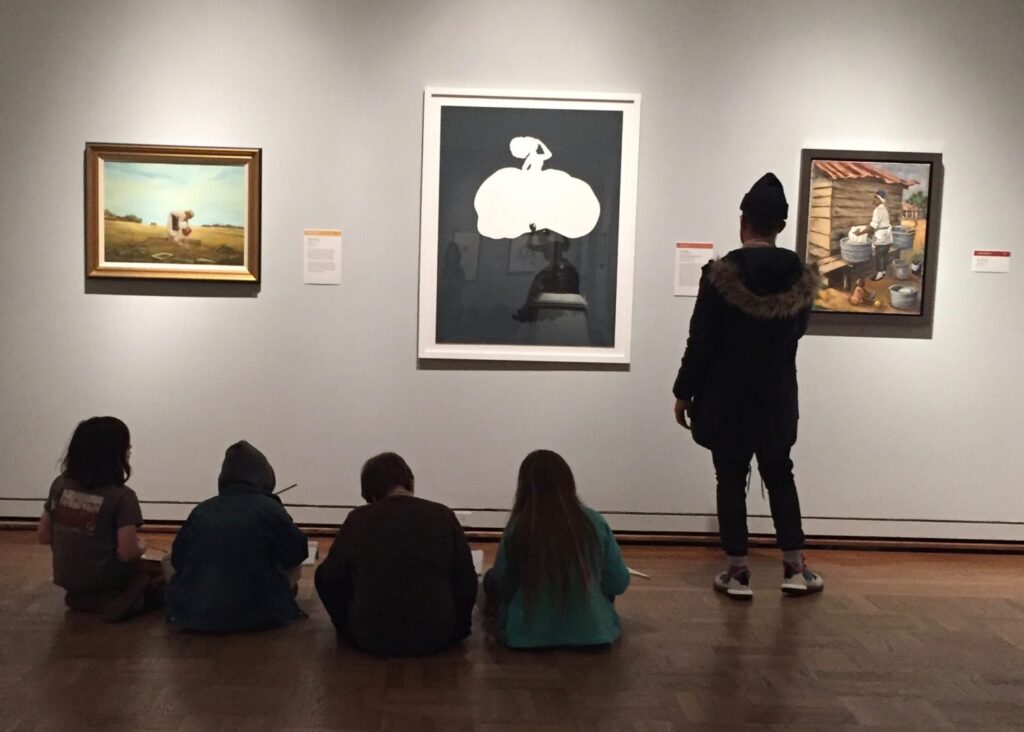
In an interview included in the exhibit catalogue, Bill Hutson, one of the artists whose work is included in the collection, said,
“I don’t think of what they think. You know what matters to me is that they think. I want them to look at the art and feel something. What bothers me is for people to look at the paintings and feel nothing.”
How often do we remember to ask children to feel? How frequently, in our planning, do we consider the emotions that are likely to be stirred by the things we ask them to think about? How likely are we to make predictions based on what students might feel because we acknowledge that there is no meaning without feeling? Feelings make us think. And thinking makes us feel. We know it is impossible not to feel. So we can be sure that the things children are feeling most are the things they are thinking most about and learning most about. How do we ensure they are learning the things we really want them to learn? What do we really want them to learn?
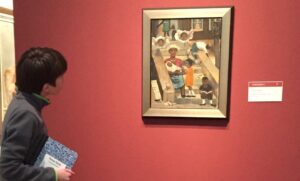 By creating conditions that allow thinking, feeling, doing, and sharing to show up simultaneously, we create conditions for young human beings to do what they arrived prepared and wanting to do: to use strategies of play to make meaning of their experience in order to find a place for themselves in the world.
By creating conditions that allow thinking, feeling, doing, and sharing to show up simultaneously, we create conditions for young human beings to do what they arrived prepared and wanting to do: to use strategies of play to make meaning of their experience in order to find a place for themselves in the world.
Consider, for a moment, what can happen when adults forget how to connect thinking and feeling — what can happen when we look at the expression of other human beings, the offer of connection, the hope for understanding — and feel nothing. The ability to dehumanize others is the result. But when we learn to see that our own identities are constructed in relationship to others, it begins to matter how others feel about what they think — and about what you think. And we begin to trust that when things don’t feel good, we just have to think harder. And we have the confidence that we can, because we don’t have to do it alone.
In “The Age of Rudeness“, Rachel Cusk writes,
“’Make her stop!’ my daughters used to beg me when they were younger and one was doing something the other didn’t like. In other words: Restore to me the primacy of my version; rid me of this challenge to the experience of being me. One might say that what they wanted was justice, impartiality — but impartiality, I usually discovered, was not easy to attain. There were always two sides to their stories, and I lacked the ability to turn them into one. I have prided myself on my willingness to object to injustices, to speak my mind when I thought I saw wrong being done. But perhaps all I was ever doing was trying to make it stop, trying to return the world to something I could bear to live in, without necessarily understanding it first.”
Our classrooms can be the places where we learn to endure the impulse to use the power we have to make our discomforts with life’s uncertainties stop — and instead make a practice of understanding. The Constructing Identity exhibition was full of opportunity to do just that. When asked, “Why does the expressive force of abstraction belong to culture and identity?”  Bill Hutson replied,
Bill Hutson replied,
“Because you can make choices that are specific choices… in many ways you can state who you are. You can state who you are even though it’s not a representation of something. You can do this with light, rhythm and color.”
An encounter with abstract art can become an invitation to stretch our tolerance for the ambiguity we need if we are to find bearable a world that is always subject to change. By inviting us to find our own connection, to make our own sense of things, it pulls us in. We find our own thoughts reflected inside the mirror the artist made for themselves. We find the world inside that piece that is common to us. Like cracking open a word to find what lives inside and to create shared culture, the abstraction invites us simply to bring what we know, and encourages us to share. This sense of belonging is the primary feeling we humans seek, so learning how to think our way there may be the most important thing we do in school. If we’re to fix this mess we’re in, real understanding must become our primary goal, and we must learn to recognize what it is. Because understanding is love.
Encounters with the arts aren’t the only way to create lasting habits of understanding, but their reflective and connective qualities make them one of the best. That is only if we give the young humans in our care chances to connect and reflect. And then do it again. And again. And as we listen to them, be the person they can rely on to bring the world to them, just when they need it most.

Thank you for linking to Grace Lin’s TED talk via MWD as it meant I found your wonderful post – I wish all young people had the chance to learn through this kind of process – ‘thinking, feeling, doing, and sharing’ through windows and mirrors and art…
Dear Susan,
There’s a collective of responses (both ‘art critic’-based and individualized experiences) already online in response to ‘Constructing Identity.’ I’m just now reading and immersing myself in your image and extra context-related post. I am illuminated inside both as artist and Curator for this exhibition by your dedication and clever means of analog interactivity for your students. As an educator for ‘donkey years,’ I’ve taught all ages. The 4th, 5th and 6th graders are capable of so much more than we expect. Thank you for creating the circumstances that have and will allow their brains and experiences to form new contours and never return to those previous to seeing this exhibition.